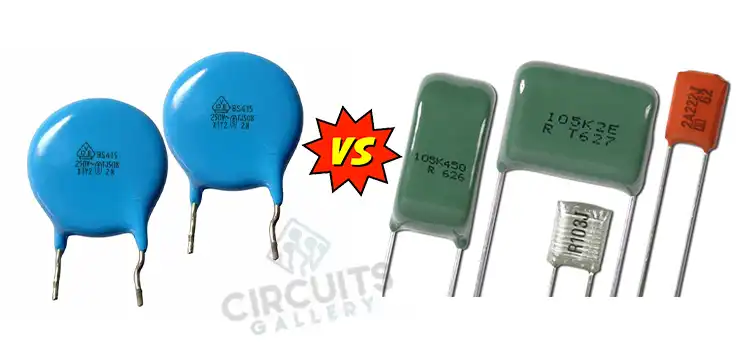Ceramic Vs Film Capacitors | Which One can Store More Electrical Energy?
Film capacitors are used more than ceramic Capacitors. Film capacitors are suitable for a wide range of capacitance values whereas ceramic capacitors are suitable for a range of capacitance.

Definition and Types of Capacitors
Capacitors are electrical devices used to store electrical energy. It consists of two conductors and one insulator. The insulator is used so that the conductors can’t transfer electricity between them.
One conductor is used as a positive conductor and another is used as a negative conductor and they store the same amount of charge (one positive charge Q+ and other negative charge Q-).
There are several types of capacitors that have different capacitance. They are-
- Ceramic capacitor
- Film capacitor
- Power capacitor
- Tantalum capacitors with solid electrolyte
- Aluminum electrolyte capacitor
- Double layer and supercapacitor
Ceramic Capacitor
In this type of capacitor ceramic material is used as the dielectric. It is a fixed value capacitor. Ceramics are used as a dielectric because it is a non metallic, The electrical behavior and the application of the capacitor are varies with the composition of the ceramic material. The range of capacitance of the ceramic capacitor is 10 pF to 1 μF.
There are mainly 4 types of capacitors-
- Class One Ceramic Capacitor
- Class Two Ceramic Capacitor
- Class Three Ceramic Capacitor
- Class Four Ceramic Capacitor
Film Capacitor
Film capacitors are also known as film caps, power film capacitors, plastic film capacitors, and polymer film capacitors which use a plastic film (any form of a film) as a dielectric. They are flexible and not very expensive. The construction is simple and easy to analyze.
There is a direct connection with the electrodes that reduce the circuit route to the electrode to a minimum. This reduces losses on transmission with high frequencies. As its structure is made of plastic films it is light and thin and can prevent damage caused by power surges. It can be coated with metal. It has a low self conductance.
Can I Use Ceramic Capacitor Instead Of Film Capacitor?
Yes, you can use a ceramic capacitor instead of film capacitor. But they are more non-linear than film capacitors in voltage and frequency. But they will be a poor choice if you compare them to film capacitors.
You can use a multi layer ceramic capacitor (MLCCs) instead of film capacitor. It is built with Strontium Bismuth Ferrum Titanate (SBFT) ceramic. This dielectric material is also known as Hitica which can withstand higher temperatures. As the flexibility of this material is low it can cause cracks in the Hitica.
To prevent the cracking a FlexiCap is used. It can prevent 50 percent of mechanical stress exerted on the ceramic section. AEC-Q200 is the certified component for building FlexiCap. It gives 5 mm bend test deflection.
It can withstand a temperature range of -40° to +105°C whereas the film capacitors can withstand a temperature range of -55° to +125°C. The voltage and capacitance of the multi layer ceramic capacitor (MLCCs) are more than the film capacitor. So, multi layer ceramic capacitors (MLCCs) will the best choice instead of film capacitors.
Difference Between Film Capacitor And Ceramic Capacitor?
The differences between film and ceramic capacitors are given below:
- Volumetric efficiency. The volumetric efficiency of ceramic capacitors is better than film capacitors.
- Mechanical stress. Film capacitors can withstand mechanical stresses better than a ceramic capacitors.
- Medium and metal. The dielectric material of the ceramic capacitor is ceramic and the film capacitor is plastic film.
- Mechanical deformation. The ceramic capacitor can withstand high temperatures. So, it can prevent mechanical deformation which film capacitors can’t.
- Applications. They both have different applications.
- Overall capacitance and voltage ratings. A film capacitor has high capacitance and voltage ratings than a ceramic capacitor.
Are Ceramic Capacitors Better?
Capacitors are used according to their need. In a ceramic capacitor, the dielectric is made of ceramic.
- A ceramic capacitor can withstand high temperatures. So, it can be used where high temperature is produced. Ceramic capacitors can withstand high voltage and power. It can tolerate voltage between 2 kV to 100 kV.
- The ceramic capacitor can be found in any size according to your need. So it is very useful where densities for the higher component are required. If you use a small size capacitor so the size of the case will be small as well and the cost will be less for the case.
- They can withstand mechanical deformation.
- The ceramic capacitor has low Effect Series Resistance (ESR) and low Effective Series Inductance (ESI) compare to the film capacitor.
- It has a better frequency response.
- Ceramic capacitors are less costly compared to other capacitors.
These characteristics will help you to choose a ceramic capacitor.
Are Film Capacitors Better?
Yes, film capacitors are better. In film capacitor plastic film are used as a dielectric.
- They are less subjectable to mechanical stresses.
- Film capacitor has low Effect Series Resistance (ESR) and low Effective Series Inductance (ESI).
- They are non-polarized capacitors.
- This type of capacitor has higher capacitance values and higher voltages.
- They are bulkier than other capacitors.
- This type of capacitor has self-healing capabilities.
- They have intrinsic elasticity.
These characteristics will help you to choose film capacitors.
Conclusion
In this article, we have discussed ceramic capacitors and film capacitors. The purposes, and the characteristics of the capacitor. The difference between the capacitors. The construction of the capacitor. Capacitors are useful electronic devices. So, we should know more about them. Thanks for reading.
Subscribe to our newsletter
& plug into
the world of circuits